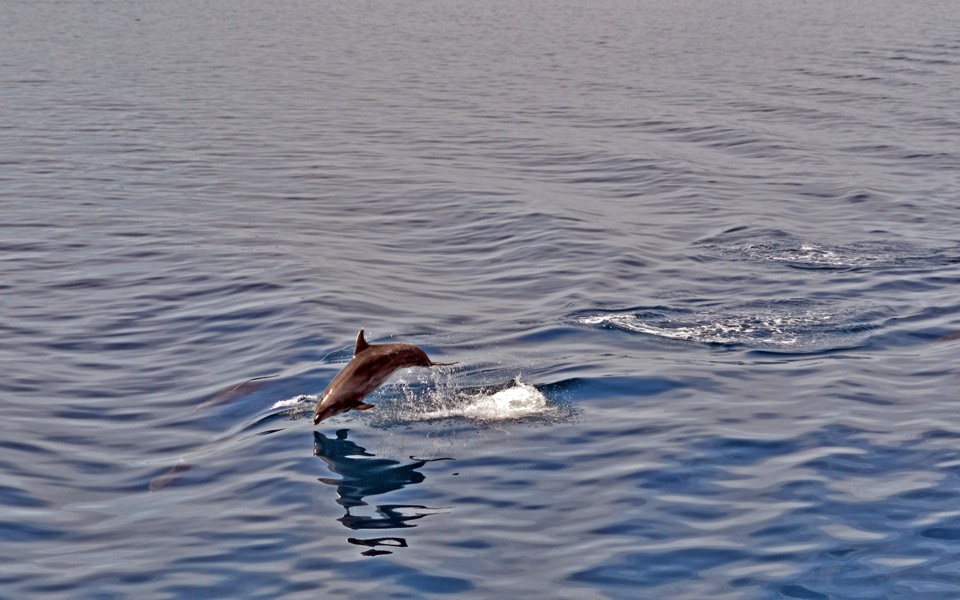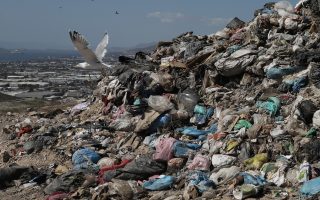Greece’s dolphins and whales in peril

The cetaceans (whales, dolphins, porpoises) swimming in European seas face much bigger threats than in all other areas of the planet. At the same time, Europe has one of the most advanced and integrated frameworks for their protection. This paradox is described in “Under Pressure,” a newly released, detailed report by OceanCare, an international organization for the protection of marine ecosystems. In the past the seas were swarming with life, herds of many hundreds of dolphins were a regular sighting for sailors and they even found their way into ancient art. How have we moved from this image to the gloomy reality of today, where even the common dolphin is endangered? Most importantly, where will we be a few years down the road if nothing changes?
Some threats could be easy to deal with. Between 2010 and 2020, whalers in Norway, the Faroe Islands, Iceland and Greenland killed 52,966 cetaceans. Their meat is mainly exported to Japan, where demand persists, or served to tourists, while their fat and bones have many uses, including being turned into souvenirs. “The science underpinning any notional sustainability of some takes (cetacean killings) is lacking,” says OceanCare. The study suggests that drastically limiting cetacean hunting is the simplest of the measures that can be taken to protect them.
Other threats are much more complex. The most valuable guide on the status of species and populations is compiled by the International Union for Conservation of Nature (IUCN). Scientists from various fields regularly assess the best available science and classify species in a range varying from “of least concern” to “extinct.” The IUCN Red List of Cetaceans in Europe lists dozens as being at risk, while of the three populations and subpopulations that are but a step before extinction (critically endangered), one lives in Greece. This is the short-beaked common dolphin (Delphinus delphis) in the Gulf of Corinth. The other two species that face an imminent danger of extinction in Europe are orcas in the Strait of Gibraltar and porpoises (small cetaceans often confused with dolphins) in the Baltic Sea.
Different dolphin species have different feeding habits and behaviors. The Gulf of Corinth is a big bay with a healthy population of approximately 1,300 striped dolphins (and one smaller mobile population of bottlenose dolphins). Yet there are only 22 common dolphins left, as every species reacts differently to environmental pressure. In order to survive, they have abandoned their own shallow water habitat where they would normally feast on sardines and anchovies, stocks of which have been depleted due to overfishing. Now they are forced to live in deeper waters, where they have joined groups of striped dolphins and mate with them.
The outline of each dolphin’s fin and the color of its body are different, so if one spends enough time observing and photographing all the dolphins in an area, one can recognize them almost individually. Italian marine biologist Giovanni Bearzi has done just that, dedicating 21 years of his life to studying dolphins in Greece, first in the Ionian Sea and then in the Corinthian Gulf. The models resulting from the work of Bearzi, together with Nina Luisa Santostasi, a specialist in the study of animal populations at La Sapienza University of Rome, and Olivier Gimenez, a French specialist in animal demography, are alarming.
In their latest research paper (Santostasi et al. 2020 in the scientific journal Ecological Modelling), the scientists predict that the chances of extinction of the population of common dolphins in the Gulf of Corinth in the next 16 years are very high. Extinction could come through hybridization between striped and common dolphins. Hybrids are already twice the number of the remaining common dolphins. “The common dolphins are very likely to disappear,” Bearzi estimates. “Hybrids are not good for a species, for sure not to the extent that it happens in the Gulf of Corinth.”
This scientific prediction applies “if nothing changes.” Bearzi remarks with sadness that the animals that survive are those that adapt to humans, like pigeons, rats, foxes or – in the case of dolphins – bottlenose dolphins, which are able to move in and out of the Gulf of Corinth and can feed on fish escaping from aquaculture facilities.
After diligent efforts by the Pelagos Cetacean Research Institute and other organizations, the Gulf of Corinth was declared a protected Natura 2000 area in 2018, but overfishing by trawlers and purse seiners has not stopped. The director of the institute, Alexandros Frantzis, points out that, beyond the common dolphins in the Gulf of Corinth, other endangered cetaceans in Greek waters include sperm whales in the Hellenic Trench, and porpoises in the Thracian Sea.
Very recently, the Greek state finally recognized the problem of sperm whales colliding with ships, but without taking the necessary steps to stop the problem, one of which is to direct shipping away from the areas in which these big cetaceans live. Another protection measure for cetaceans would be reducing anthropogenic noise by lowering the speed of vessels, as proposed in detail in the OceanCare report. In any case, the measures must be real, not merely theoretical. As Bearzi points out, “protection must be of a kind that the dolphins can notice.” They are smart animals, you can’t trick them so easily.





